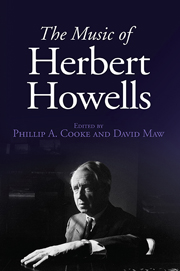Book contents
- Frontmatter
- Dedication
- Contents
- List of Illustrations
- List of Musical Examples
- List of Tables
- List of Contributors
- Foreword
- Acknowledgements
- Miscellaneous Frontmatter
- Introduction: Paradox of an Establishment Composer
- PART I Howells the Stylist
- 1 ‘In matters of art friendship should not count’: Stanford and Howells
- 2 Howells and Counterpoint
- 3 Window on a Complex Style: Six Pieces for Organ
- PART II Howells the Vocal Composer
- PART III Howells the Instrumental Composer
- PART IV Howells the Modern
- PART V Howells in Mourning
- Appendix: Catalogue of the Works of Herbert Howells
- Bibliography
- Index of Works
- General Index
2 - Howells and Counterpoint
from PART I - Howells the Stylist
Published online by Cambridge University Press: 05 December 2013
- Frontmatter
- Dedication
- Contents
- List of Illustrations
- List of Musical Examples
- List of Tables
- List of Contributors
- Foreword
- Acknowledgements
- Miscellaneous Frontmatter
- Introduction: Paradox of an Establishment Composer
- PART I Howells the Stylist
- 1 ‘In matters of art friendship should not count’: Stanford and Howells
- 2 Howells and Counterpoint
- 3 Window on a Complex Style: Six Pieces for Organ
- PART II Howells the Vocal Composer
- PART III Howells the Instrumental Composer
- PART IV Howells the Modern
- PART V Howells in Mourning
- Appendix: Catalogue of the Works of Herbert Howells
- Bibliography
- Index of Works
- General Index
Summary
The music of Herbert Howells is inseparable from counterpoint: indeed, he considered himself to belong to the Tudor period ‘not only musically but in every way’. That was an intensely polyphonic era, and he himself normally thought in counterpoint (a trait he shared with Vaughan Williams). Thus the underlying feeling of ‘H. H. His Fancy’ (written in 1927) is of a meditative and dreamy fugue, the word ‘Fancy’ standing both for the Tudor idea of ‘imitative fantasia’ and for ‘the kind of music most admired by H. H.’ As it happens, ‘Foss's Dump’ (no. 6 in the same collection) is also a fugue, but it is perhaps surprising that the piece written for H. K. Andrews (no. 6 in Book 1 of Howells' Clavichord – HH 237) – that expert on all things pertaining to Palestrina and Byrd – eschews imitative counterpoint in favour of a melodic line with clear roots in Tudor keyboard dances, though with flowing contrapuntal accompaniment. Indeed, Howells's interest in Tudor music appears to have veered more towards the dance and air than towards the imitative fantasia or motet: ‘Master Tallis's Testament’ (from the Six Pieces for Organ of 1939–45 – HH 226) provides a modal tune with modally inflected supporting harmony, but does not use imitative counterpoint (even though Tallis was an expert at writing it); and when Bartök had tea with him in London, Howells demonstrated Tudor keyboard music by playing Farnaby's ‘His Rest’ and ‘Tower Hill’, and two pieces by Byrd (a pavane and ‘The Carman's Whistle’) – but not any of the Tudor imitative fantasias.
- Type
- Chapter
- Information
- The Music of Herbert Howells , pp. 22 - 36Publisher: Boydell & BrewerPrint publication year: 2013

